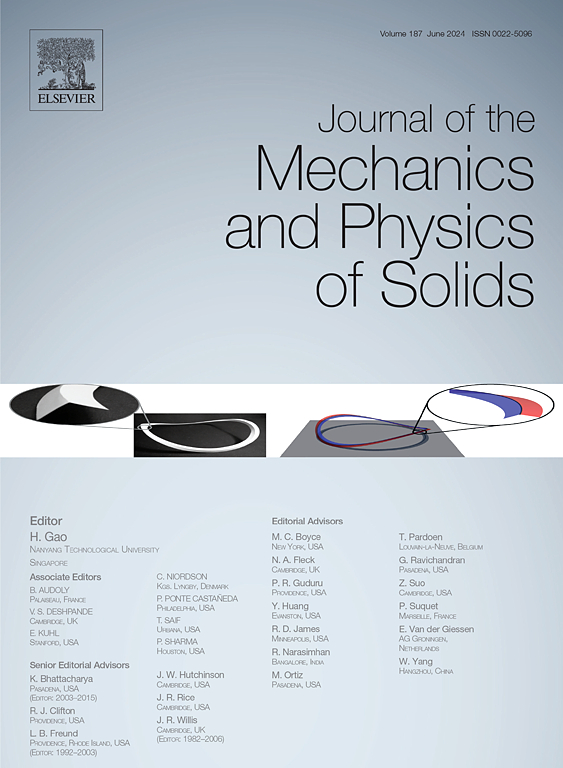Analysis of axisymmetric necking of a circular dielectric membrane based on a one-dimensional model
IF 5
2区 工程技术
Q2 MATERIALS SCIENCE, MULTIDISCIPLINARY
引用次数: 0
Abstract
To facilitate the understanding of the mechanisms underlying the electric breakdown of dielectric elastomers, we derive a one-dimensional (1d) model for axisymmetric necking in a dielectric membrane subjected to equibiaxial stretching and an electric field, starting from the three-dimensional (3d) nonlinear electroelasticity theory. Our reduction is built on the variational asymptotic method, so that the resulting 1d model is asymptotically self-consistent. The 1d model offers an easier and more efficient way to analyze axisymmetric necking in a dielectric membrane in the linear, weakly nonlinear and fully nonlinear regimes. It delivers results identical to the 3d theory in the linear and weakly nonlinear regimes, and near-identical results in the fully nonlinear regime due to its asymptotic self-consistency. We demonstrate the straightforward implementation of this 1d model by solving it using the Rayleigh–Ritz method and validate it by comparison with finite-element simulations. The 1d model enables a precise calculation of the minimum thickness that a dielectric membrane can reach when necking instability occurs and quantitative assessment of the effects of imperfections so that the integrity of a dielectric elastomer actuator can be evaluated with respect to electric breakdown. The developed methodology is not problem-specific and can also be applied to analyze similar phenomena in other soft materials subjected to any fields (e.g., the axisymmetric necking of stretched plastic membranes).
基于一维模型的圆形介质膜轴对称缩颈分析
为了便于理解介电弹性体电击穿的机制,我们从三维非线性电弹性理论出发,推导了受等双轴拉伸和电场作用的介电膜轴对称颈缩的一维模型。我们的约简是建立在变分渐近方法上的,因此得到的一维模型是渐近自洽的。一维模型为分析介电膜在线性、弱非线性和全非线性条件下的轴对称颈缩提供了一种更简单、更有效的方法。由于其渐近自洽性,它在线性和弱非线性情况下得到与三维理论相同的结果,在完全非线性情况下得到与三维理论几乎相同的结果。我们通过使用瑞利-里兹方法求解该一维模型,并通过与有限元模拟的比较验证了该模型的直接实现。一维模型可以精确计算当颈缩不稳定发生时介电膜可以达到的最小厚度,并定量评估缺陷的影响,从而可以根据电击穿评估介电弹性体致动器的完整性。所开发的方法不是特定问题,也可以应用于分析其他软材料受到任何场的类似现象(例如,拉伸塑料膜的轴对称颈缩)。
本文章由计算机程序翻译,如有差异,请以英文原文为准。
求助全文
约1分钟内获得全文
求助全文
来源期刊
CiteScore
9.80
自引率
9.40%
发文量
276
审稿时长
52 days
期刊介绍:
The aim of Journal of The Mechanics and Physics of Solids is to publish research of the highest quality and of lasting significance on the mechanics of solids. The scope is broad, from fundamental concepts in mechanics to the analysis of novel phenomena and applications. Solids are interpreted broadly to include both hard and soft materials as well as natural and synthetic structures. The approach can be theoretical, experimental or computational.This research activity sits within engineering science and the allied areas of applied mathematics, materials science, bio-mechanics, applied physics, and geophysics.
The Journal was founded in 1952 by Rodney Hill, who was its Editor-in-Chief until 1968. The topics of interest to the Journal evolve with developments in the subject but its basic ethos remains the same: to publish research of the highest quality relating to the mechanics of solids. Thus, emphasis is placed on the development of fundamental concepts of mechanics and novel applications of these concepts based on theoretical, experimental or computational approaches, drawing upon the various branches of engineering science and the allied areas within applied mathematics, materials science, structural engineering, applied physics, and geophysics.
The main purpose of the Journal is to foster scientific understanding of the processes of deformation and mechanical failure of all solid materials, both technological and natural, and the connections between these processes and their underlying physical mechanisms. In this sense, the content of the Journal should reflect the current state of the discipline in analysis, experimental observation, and numerical simulation. In the interest of achieving this goal, authors are encouraged to consider the significance of their contributions for the field of mechanics and the implications of their results, in addition to describing the details of their work.

 求助内容:
求助内容: 应助结果提醒方式:
应助结果提醒方式:


